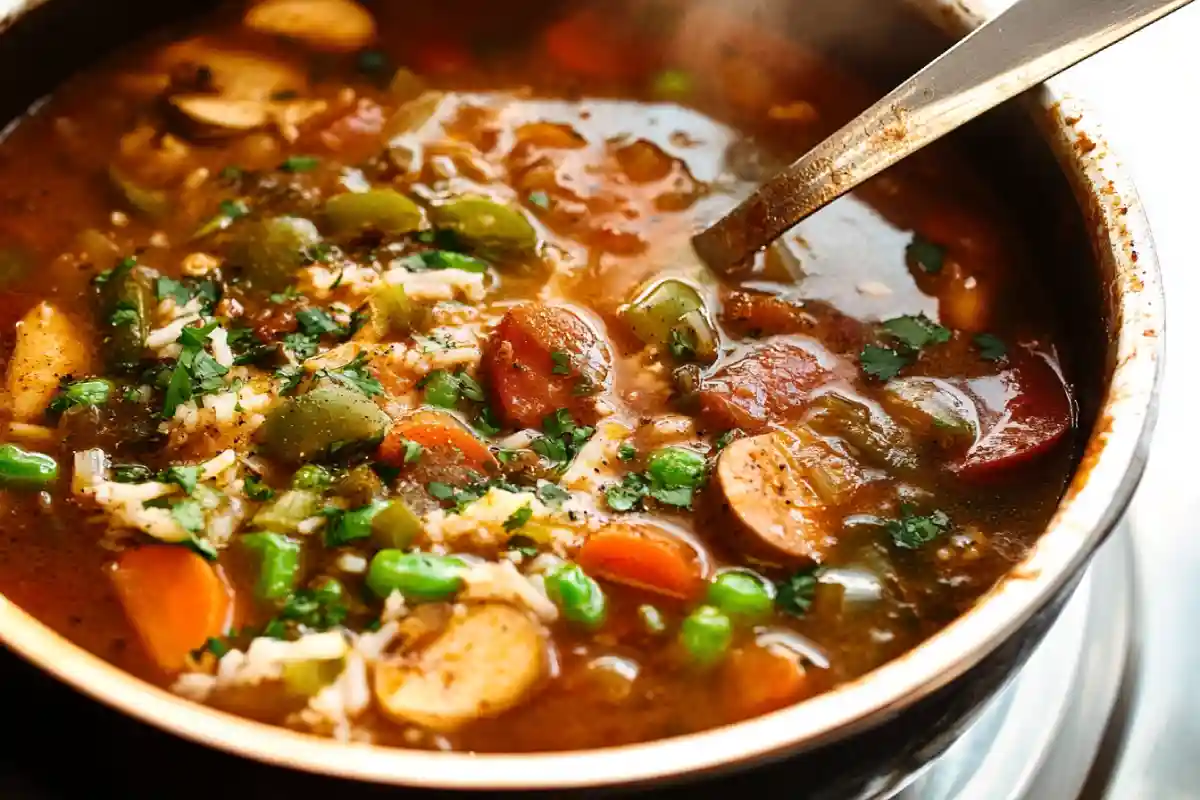
Table of Contents
After 20 test pots, this is the only favorite gumbo recipe I still cook on chilly Sundays: a bittersweet-chocolate roux, juicy bone-in chicken, beef-turkey andouille, and late-add shrimp for surf-and-turf magic. A tight 40-minute simmer melts the trinity, keeps rice fluffy, and fills the kitchen with bayou perfume.
The Taste of Gumbo Explained
If you’re wondering what does gumbo taste like, you’re not alone. The taste of gumbo is as layered as its ingredients, offering a bold, savory, and often smoky experience. Because there are many styles, the flavor can range from earthy and hearty to rich and spicy. Yet, despite the variations, one thing remains consistent—gumbo delivers comfort in every bite.
To fully appreciate your favorite gumbo, it helps to break down its core elements. Although the ingredients may vary, each component adds depth to the flavor profile. That’s why understanding the taste begins with knowing what typically goes into a gumbo:
- Roux, the browned flour and fat base, gives gumbo its deep, toasty flavor
- The Holy Trinity—onions, bell peppers, and celery—builds aromatic richness
- Spices such as cayenne, paprika, and thyme contribute layers of warmth
- Meats or seafood add protein and influence overall taste
For a helpful deep dive into how spices shape Southern cuisine, check out this guide on Cajun vs Creole flavors from Flavivo Recipes. This internal article provides clear examples that can help you understand why certain versions of favorite gumbo appeal more to your taste buds than others.
In addition to ingredients, cooking method also impacts flavor. A gumbo simmered for hours will develop a more integrated taste compared to a quicker version. Even so, both can be delicious if balanced properly. The goal is to reach that ideal harmony—where every spoonful feels like home.
Types of Gumbo: Finding Your Favorite
There’s no one-size-fits-all when it comes to favorite gumbo. Instead, there’s a flavorful variety of gumbo types that reflect different regional traditions, ingredient preferences, and cooking styles. Because of this diversity, exploring the different types is essential in discovering the version that resonates most with your taste.
Though gumbo can be made in countless ways, three types are considered the most well-known. Each one offers its own unique flavor profile, ingredients, and texture:
- Seafood Gumbo – A coastal classic that highlights shrimp, crab, and sometimes oysters, often using okra as a thickener.
- Chicken and Sausage Gumbo – Hearty and smoky, this version uses a dark roux and the Holy Trinity of vegetables.
- Vegetarian or Modern Gumbo – A lighter alternative, focusing on seasonal vegetables and meat-free thickeners like filé powder.
In fact, if you’re curious about how chicken and seafood can come together in one dish, this chicken and seafood gumbo recipe from Flavivo Recipes is a must-read. It showcases how blending proteins can create a deeply satisfying flavor—a great guide for those still seeking their favorite gumbo.
What’s more, the choice of thickener plays a critical role in distinguishing gumbo types. For example:
- Okra adds body and subtle earthiness.
- Filé powder, made from sassafras leaves, gives a slightly herbal finish.
- A dark roux adds rich, toasted depth—especially in meat-based gumbos.
Furthermore, gumbo styles often reflect their regional roots. Creole gumbo, for instance, typically includes tomatoes and seafood, while Cajun gumbo leans toward darker roux and more robust spice.
For a culturally rich comparison, Louisiana Travel’s guide offers a helpful perspective on gumbo’s historical development and regional distinctions.
Ultimately, finding your favorite gumbo depends on flavor, texture, and even nostalgia. Whether you prefer it with seafood, meat, or veggies, each bowl tells a story. And by trying different versions, you’ll not only satisfy your palate—but also discover the gumbo that feels like home.
Ingredients That Define a Favorite Gumbo
Not all gumbo is created equal, and the secret to discovering your favorite gumbo lies in the ingredients. While cooking technique is important, it’s the components of the dish that shape its identity. Because of this, knowing which elements truly make a difference will help you build the perfect bowl.
Although recipes vary, most gumbos begin with a few foundational items that work together to create deep, complex flavor. These include:
- Roux – A mix of fat and flour, cooked until it darkens. This base adds richness and a nutty depth that defines authentic gumbo.
- The essential trio: onion, celery, and bell pepper. These vegetables are sautéed together and serve as the aromatic backbone of the dish.
- Proteins – Chicken, sausage, shrimp, or crab are common choices. Often, more than one protein is used for balance.
- Okra or Filé Powder – These ingredients thicken the gumbo and give it that distinct Southern texture.
In addition, seasoning is everything. Without proper spices—such as cayenne pepper, paprika, and thyme—the gumbo can fall flat. Therefore, getting this blend right is essential for flavor.
If you’re curious about the roots of this classic mix, you might enjoy reading this deep dive into Louisiana dishes, which explores other iconic meals shaped by similar ingredients and traditions. It’s a great internal link that adds even more context to the ingredients behind your favorite gumbo.
Furthermore, choosing high-quality ingredients makes a noticeable difference. Opting for fresh vegetables, homemade stock, and well-seasoned sausage will elevate your gumbo from good to unforgettable.
Ultimately, once you understand these components and how they interact, you’ll be better equipped to personalize your own favorite gumbo. Whether you prefer it spicy or savory, meaty or full of seafood, it all starts with the right ingredients.
Frequently Asked Questions About Gumbo
When it comes to choosing your favorite gumbo, it’s natural to have questions—especially with so many variations and regional traditions. Therefore, this section covers essential FAQs to help you better understand the dish and what makes one gumbo stand out over another. These answers can guide you toward discovering which gumbo might become your personal favorite.
What three types of gumbo are most popular?
Seafood gumbo, chicken and sausage gumbo, and vegetarian gumbo are the three most popular varieties. Seafood gumbo highlights ingredients like shrimp and crab, often thickened with okra. Chicken and sausage gumbo is known for its smoky flavor and hearty texture, usually made with a dark roux. Vegetarian gumbo skips the meat and seafood, focusing instead on rich vegetable bases and filé powder for flavor and consistency.
What are the 2 rules of gumbo?
The first rule of gumbo is to never rush the roux. A properly cooked roux develops the deep, toasted flavor that gives gumbo its signature taste. The second rule is to avoid overcooking the seafood. Shrimp and crab should be added near the end of cooking to keep them tender and flavorful, not rubbery or tough.
What is the secret to good gumbo?
The secret to good gumbo lies in building layers of flavor slowly. Starting with a rich roux, then adding aromatic vegetables and simmering the proteins gently allows each ingredient to develop its own depth. Seasoning is also key—balancing spice, salt, and herbs creates a gumbo that’s bold yet smooth. When made with care, these steps lead to a bowl of gumbo that could easily become your favorite gumbo.
Which city is famous for gumbo?
New Orleans is the city most famous for gumbo. As the heart of Creole and Cajun cuisine, it’s known for its flavorful, diverse versions of this beloved dish. However, gumbo is also widely celebrated throughout Louisiana, where local traditions influence the many ways people prepare their favorite gumbo.
Conclusion: Choosing Your Favorite Gumbo
Finding your favorite gumbo is more than just a food preference—it’s a flavorful journey rooted in tradition, culture, and personal taste. While the process may begin with sampling a few bowls, it quickly becomes about discovering the version that speaks to your senses and memories. Whether you lean toward seafood, chicken and sausage, or a vegetable-rich gumbo, each bite brings you closer to that perfect bowl.
Because gumbo is incredibly adaptable, it allows for endless variations. This flexibility means you’re not limited to one recipe. Instead, you can adjust based on your mood, ingredients on hand, or the type of comfort you’re craving. To help guide your next steps, consider the key points below:
What to Consider When Choosing Your Favorite Gumbo
| Factor | Why It Matters |
|---|---|
| Roux Color | A lighter roux creates a milder flavor, while a darker roux adds depth and richness. |
| Protein Preference | Seafood brings a sweet, briny taste; chicken and sausage offer hearty, smoky flavors. |
| Thickener Used | Okra adds body and earthiness; filé powder offers herbal notes. |
| Spice Level | Some prefer a bold kick, while others enjoy mild, subtle warmth. |
| Texture and Consistency | Creamy or broth-like, the texture affects how satisfying your gumbo feels. |
Because no single recipe works for everyone, it’s perfectly okay to mix and match ingredients until your ideal version comes to life. For some, a gumbo rich with shrimp and okra hits the mark. For others, a smoky sausage blend with extra spice becomes the ultimate comfort food. Regardless of which direction you take, the result is a dish full of heart.
In the end, the best way to discover your favorite gumbo is to keep tasting, keep experimenting, and keep sharing. Gumbo is not just food—it’s a reflection of who you are and the flavors you hold dear.
